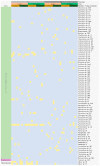The Invasive Tradescantia zebrina Affects Litter Decomposition, but It Does Not Change the Lignocellulolytic Fungal Community in the Atlantic Forest, Brazil
- PMID: 37299140
- PMCID: PMC10255722
- DOI: 10.3390/plants12112162
The Invasive Tradescantia zebrina Affects Litter Decomposition, but It Does Not Change the Lignocellulolytic Fungal Community in the Atlantic Forest, Brazil
Abstract
Invasive plants affect ecosystems across various scales. In particular, they affect the quality and quantity of litter, which influences the composition of decomposing (lignocellulolytic) fungal communities. However, the relationship among the quality of invasive litter, lignocellulolytic cultivated fungal community composition, and litter decomposition rates under invasive conditions is still unknown. We evaluated whether the invasive herbaceous Tradescantia zebrina affects the litter decomposition in the Atlantic Forest and the lignocellulolytic cultivated fungal community composition. We placed litter bags with litter from the invader and native plants in invaded and non-invaded areas, as well as under controlled conditions. We evaluated the lignocellulolytic fungal communities by culture method and molecular identification. Litter from T. zebrina decomposed faster than litter from native species. However, the invasion of T. zebrina did not alter decomposition rates of either litter type. Although the lignocellulolytic fungal community composition changed over decomposition time, neither the invasion of T. zebrina nor litter type influenced lignocellulolytic fungal communities. We believe that the high plant richness in the Atlantic Forest enables a highly diversified and stable decomposing biota formed in conditions of high plant diversity. This diversified fungal community is capable of interacting with different litter types under different environmental conditions.
Keywords: in situ; in vitro; litter bags; microbiota; native plants; nutrient cycling; protected areas.
Conflict of interest statement
The authors declare no conflict of interest.
Figures



Similar articles
-
Structural and functional changes in the fungal community of plant detritus in an invaded Atlantic Forest.BMC Microbiol. 2022 Jan 5;22(1):10. doi: 10.1186/s12866-021-02431-8. BMC Microbiol. 2022. PMID: 34986801 Free PMC article.
-
Seasonality and forest edge as drivers of Tradescantia zebrina Hort. ex Bosse invasion in the Atlantic Forest.Braz J Biol. 2021 Apr 2;82:e238403. doi: 10.1590/1519-6984.238403. eCollection 2021. Braz J Biol. 2021. PMID: 33825758
-
Limited Effects of Variable-Retention Harvesting on Fungal Communities Decomposing Fine Roots in Coastal Temperate Rainforests.Appl Environ Microbiol. 2018 Jan 17;84(3):e02061-17. doi: 10.1128/AEM.02061-17. Print 2018 Feb 1. Appl Environ Microbiol. 2018. PMID: 29180362 Free PMC article.
-
Decoupling the direct and indirect effects of climate on plant litter decomposition: Accounting for stress-induced modifications in plant chemistry.Glob Chang Biol. 2018 Apr;24(4):1428-1451. doi: 10.1111/gcb.13923. Epub 2018 Jan 28. Glob Chang Biol. 2018. PMID: 28986956 Review.
-
Using experimental manipulation to assess the roles of leaf litter in the functioning of forest ecosystems.Biol Rev Camb Philos Soc. 2006 Feb;81(1):1-31. doi: 10.1017/S1464793105006846. Biol Rev Camb Philos Soc. 2006. PMID: 16460580 Review.
References
-
- Berg B., McClaugherty C. Plant Litter: Decomposition, Humus Formation, Carbon Sequestration. 3rd ed. Springer; Berlin/Heidelberg, Germany: 2014. p. 317.
-
- Krishna M.P., Mohan M. Litter decomposition in forest ecosystems: A review. Energy Ecol. Environ. 2017;2:236–249. doi: 10.1007/s40974-017-0064-9. - DOI
-
- Hättenschwiler S., Tiunov A.V., Scheu S. Biodiversity and litter decomposition in terrestrial ecosystems. Annu. Rev. Ecol. Evo. Syst. 2005;36:191–218. doi: 10.1146/annurev.ecolsys.36.112904.151932. - DOI
Grants and funding
LinkOut - more resources
Full Text Sources

